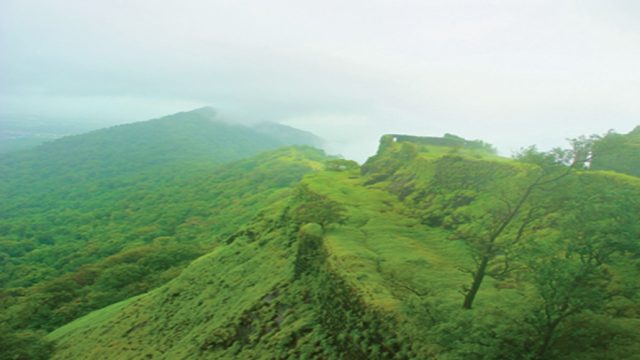Vajreshwari, with its hot springs, is one of those places where the pilgrim and the weekender can truly and peacefully coexist. And they normally do, sometimes in the same hot water tank. The organising principle of Vajreshwari is to send you to some temple or the other. Narrow lanes are littered with flowers, pilgrims walk barefoot on the hot concrete and there are hawkers selling platters comprising incense sticks, vermilion, camphor and coconuts, offerings which are meant to appease the gods. Contrary to what the hawkers will tell you, it is not essential to buy these to gain access to the temple.
Vajreshwari is at the foot of the Mandakini mountain, which was formed as a result of a volcanic eruption. It is this proximity that accounts for the many hot springs in this region.
THINGS TO SEE AND DO
While the grand Vajreshwari Temple is always touted as the best thing about this town by the locals, it is the mysterious excess of hot springs here that really makes the town unique.

Vajreshwari Temple
In 1739, Maratha warrior Chimaji Appa attacked Vasai Fort, which belonged to the Portuguese. Before he set out to fight the powerful Europeans, he prayed to Goddess Vajreshwari on the way, and in return for a successful belting of the Christians, he promised to build a grand temple in her honour. After his effective conquest, he fulfilled his promise. The temple is reached after a steep climb, and at its doors, there are huge boards that proudly advertise the conquest by Chimaji Appa. The goddess inside seems quite unmindful of the fuss at the very door of her abode. A small climb from the temple leads to a point from where there is a good view of the distant hills.
Akloli Kund
About a kilometre from the famed temple is a curious place called Akloli where a cluster of seven hot springs are trapped in 5-ft-deep cement tanks. The hot springs are said to have curative powers. In the backdrop of the hot springs is the Tansa river.
The springs of Akloli keep the tanks perenially full. Since it is essentially running water, the fact that hundreds take a bath in these tanks should not be a cause of serious worry. What you should concentrate on is tentatively dipping the feet into the tanks before plunging in, because in two of them the water is hot enough to cause minor burns. You may see some local women standing in the tubs without any obvious discomfort. They have become accustomed to the heat – attempting parity may be hazardous. Try the other tanks, the waters in which are quite pleasantly warm.
Sadly it’s an affront to whichever god had the wisdom to send these springs upwards that they are contained in crude tiled receptacles. Akloli has the potential to be a fantastic tourist spot, but perhaps we don’t care enough to keep things beautiful and clean.
Though anyone can take a dip at any time of the day or night, it is from sunrise to late evening that the enterprising locals come up with their makeshift tents that provide spare shorts for men and ‘night gowns’ for women for a small fee. Women can change here behind cloth partitions.
Ganeshpuri
About 2 km from Vajreshwari is Ganeshpuri, a quaint town filled with temples. Here there is a Nityanand Mandir that was built in the memory of a great loin-clothed sage who took samadhi here over five decades ago, in 1961. The temple is a marble and granite structure that has a quiet, peaceful ambience. There are small shops in the courtyard with trinkets and souvenirs for sale. Most of the time there is the deafening silence of men and women inside the temple, all of whom have congregated to meditate. Aarti is held five times a day at the temple, and pilgrims can also to stay here (see W nityanand.org for details).
Near the temple are three hot spring tanks, which are usually not as crowded as the ones in Akloli. The river that runs behind the temple has a tank called Agni Kund that is accessible during dry seasons. Here the water is so hot that villagers say they bundle rice in a clean cloth and dip it in. In a few minutes the rice is cooked! The more sensitive visitors should avoid venturing in.
WHERE TO STAY AND EAT
Vajreshwari has many lodges. It is easy for all visitors to find a shelter of their choice and within their budget in the town. Prime among these is Tansa Resort (Tel: 02522– 261252; Tariff: ₹500–1,000) at Akloli Kund, which has 13 rooms with room service, cable TV as well as a restaurant.
Other options include Sea Gull Resort (Cell: 09890228228; Tariff: ₹1,500–2,500) and Kalyani Village (Cell: 09820040457, 09769330696; Tariff: ₹3,800, with meals).
Vajreshwari offers the regular semi-rural Maharashtrian fare but for those with south Indian tastebuds, Ganeshpuri is a better place. The restaurant at Tansa Resort has a decent menu featuring Marwari, Gujarati, Indian and Chinese food. Sea Gull Resort also has a restaurant and bar.
FAST FACTS |
When to go All year round, but a hot spring dip is a great experience on a cold winter day |
Tourist Office |
MTDC Mumbai Region Konkan Location On the banks of the Tansa river in Thane District, just north of Mumbai Distance 86 km N of Mumbai |
GETTING THERE |
Air Nearest airport: Mumbai (86 km/ 2 hrs) Taxi costs ₹3,000–3,500 |
Rail Nearest railhead: Virar (34 km/ 1 hr). Better road from Vasai Road Station. Auto costs Rs. 400. Local trains from Churchgate to Vasai Road and Virar ply every few minutes |
Road Take the Western Express Highway (NH8) to Mandavi past Dahisar Check Naka and Kashimira. Turn right at Shirsad and go straight via Mandavi, Chandip, Ganeshpuri and Nalla Sopara to Vajresh wari. |
Bus ST buses ply to Akloli and Vajreshwari from Thane, Virar and Vasai |




